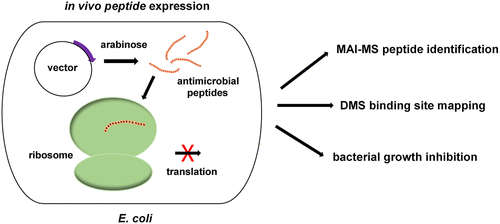当前位置:
X-MOL 学术
›
Biochemistry
›
论文详情
Our official English website, www.x-mol.net, welcomes your feedback! (Note: you will need to create a separate account there.)
Expression and In Vivo Characterization of the Antimicrobial Peptide Oncocin and Variants Binding to Ribosomes.
Biochemistry ( IF 2.9 ) Pub Date : 2020-08-25 , DOI: 10.1021/acs.biochem.0c00600 Nisansala S Muthunayake 1, 2 , Rabiul Islam 1 , Ellen D Inutan 3 , Wesley Colangelo 2 , Sarah Trimpin 1 , Philip R Cunningham 2 , Christine S Chow 1
Biochemistry ( IF 2.9 ) Pub Date : 2020-08-25 , DOI: 10.1021/acs.biochem.0c00600 Nisansala S Muthunayake 1, 2 , Rabiul Islam 1 , Ellen D Inutan 3 , Wesley Colangelo 2 , Sarah Trimpin 1 , Philip R Cunningham 2 , Christine S Chow 1
Affiliation

|
Peptides have important biomedical applications, but poor correlation between in vitro and in vivo activities can limit their development for clinical use. The ability to generate peptides and monitor their expression with new mass spectrometric methods and biological activities in vivo would be an advantage for the discovery and improvement of peptide-based drugs. In this study, a plasmid-based system was used to express the ribosome-targeting peptide oncocin (19 amino acids, VDKPPYLPRPRPPRRIYNR) and to determine its direct antibacterial effects on Escherichia coli. Previous biochemical and structure studies showed that oncocin targets the bacterial ribosome. The oncocin peptide generated in vivo strongly inhibits bacterial growth. In vivo dimethyl sulfate footprinting of oncocin on the rRNA gives results that are consistent with those of in vitro studies but reveals additional binding interactions with E. coli ribosomes. Furthermore, expression of truncated or mutated peptides reveals which amino acids are important for antimicrobial activity. Overall, the in vivo peptide expression system can be used to investigate biological activities and interactions of peptides with their targets within the cellular environment and to separate contributions of the sequence to cellular transport. This strategy has future applications for improving the effectiveness of existing peptides and developing new peptide-based drugs.
中文翻译:

抗菌肽癌蛋白及其与核糖体结合的变体的表达和体内表征。
肽具有重要的生物医学应用,但体外和体内活性之间的相关性较差会限制其在临床上的发展。产生肽并通过新的质谱方法监测其表达的能力以及体内的生物活性将是发现和改进基于肽的药物的一个优势。在这项研究中,基于质粒的系统用于表达靶向核糖体的肽癌蛋白(19个氨基酸,VDKPPYLPRPRPPRRIYNR)并确定其对大肠杆菌的直接抗菌作用。先前的生化和结构研究表明,癌基因靶向细菌核糖体。体内产生的癌蛋白肽强烈抑制细菌生长。体内硫酸二甲酯在rRNA上的脚印在脚印上产生的结果与体外研究一致,但揭示了与大肠杆菌核糖体的其他结合相互作用。此外,截短或突变的肽的表达揭示了哪些氨基酸对抗菌活性很重要。总体而言,体内肽表达系统可用于研究细胞环境中肽的生物学活性和肽与其靶标的相互作用,并分离序列对细胞运输的贡献。该策略在提高现有肽的有效性和开发新的基于肽的药物方面具有未来的应用。
更新日期:2020-09-15
中文翻译:

抗菌肽癌蛋白及其与核糖体结合的变体的表达和体内表征。
肽具有重要的生物医学应用,但体外和体内活性之间的相关性较差会限制其在临床上的发展。产生肽并通过新的质谱方法监测其表达的能力以及体内的生物活性将是发现和改进基于肽的药物的一个优势。在这项研究中,基于质粒的系统用于表达靶向核糖体的肽癌蛋白(19个氨基酸,VDKPPYLPRPRPPRRIYNR)并确定其对大肠杆菌的直接抗菌作用。先前的生化和结构研究表明,癌基因靶向细菌核糖体。体内产生的癌蛋白肽强烈抑制细菌生长。体内硫酸二甲酯在rRNA上的脚印在脚印上产生的结果与体外研究一致,但揭示了与大肠杆菌核糖体的其他结合相互作用。此外,截短或突变的肽的表达揭示了哪些氨基酸对抗菌活性很重要。总体而言,体内肽表达系统可用于研究细胞环境中肽的生物学活性和肽与其靶标的相互作用,并分离序列对细胞运输的贡献。该策略在提高现有肽的有效性和开发新的基于肽的药物方面具有未来的应用。



























 京公网安备 11010802027423号
京公网安备 11010802027423号